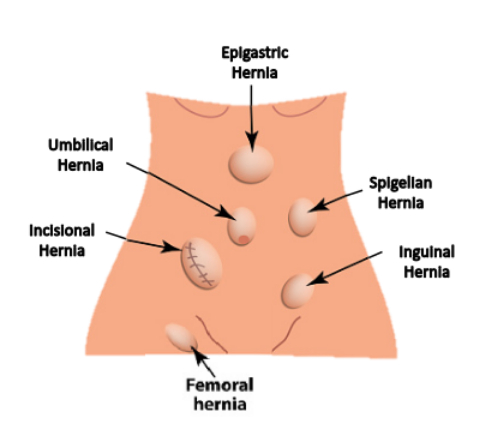What is a Hernia?
A hernia is a lump protruding through your abdominal wall. If relaxed (such as lying down) this lump should disappear (reduce) or you should be able to push it back so it goes back in. It might go in and pop out again when you use your tummy muscles or stand up.
Hernias have different names depending on where they appear on the body. Types of hernia include inguinal hernia and umbilical hernia. The definition and details are below.
Types of abdominal hernia
Abdominal wall hernias are a hernia that comes through an area of the abdominal wall. The abdominal wall has weak spots and over time hernias can occur through these.
All abdominal wall hernias share one thing in common. The lining of the abdomen called the parietal peritoneum pokes through a hole or defect in the abdominal wall muscles/ connective tissue known as an aponeurosis. Different hernias poke through different areas of weakness in the abdominal wall. If the peritoneum pokes through the hole in this aponeurosis, then the contents of the abdomen can get trapped in that hole causing symptoms such as discomfort.
We can split them into 2 types.
– Groin (inguinal, femoral)
– Ventral abdominal wall hernias (umbilical/paraumbilical, epigastric, incisional, spigelian/lateral)
Inguinal hernias are in the groin and commonly known as a groin hernia. These are the most regular occuring type of hernia affecting 1 in 8 men.
Femoral hernias are very low in the groin, more frequent in women than men
Umbilical / Paraumbilical hernias pop through close to the belly button
Epigastric hernias are halfway between the bottom of the breast bone and the belly button
Spigelian / Lumbar hernias are rare and occur in your side.
Incisional hernias are herniation through an old operation site.
Parastomal hernias. These are also rare. They are like an incisional hernia and form around a stoma.
At Hernia Clinic Hampshire we specialise in hernia repair for many types of hernia and on men and women old and young.
Please note: Mr Kirkby-Bott cannot help with hiatus or parastomal hernias.
Symptoms caused by a hernia
Many hernias are reducible lumps that can be pushed back. Hernias do not always cause any symptoms other than the lump. Hernias cause symptoms when they are protruding (visible/palpable lump). Symptoms include an ache, dragging or pulling sensation and pain or discomfort that worsens as activity continues. These improve when the aggravating activity ceases and the hernia reduces back in. These symptoms are felt at or near the site of the lump. Groin hernias can cause testicle discomfort.
How do I know if I have a hernia?
A typical description of a hernia is something like this:
You will have noticed a lump that comes and goes somewhere on the wall of your tummy or groin.
It can ache and be painful and is made worse by lifting or exercising.
The symptoms get worse as the day progresses.
When you go to bed the hernia reduces and often feels comfortable again.
When you wake up in the morning the symptoms are better but it protrudes out when you are up and showering, and so the cycle repeats.
If ignored these symptoms can progressively worsen to the point it becomes too painful or worrying to perform certain activities: Work, house jobs, walking and exercising can all suffer. If left the lump can stop going back in by itself and needs to be pushed back in. Eventually it won’t push back and the symptoms don’t get better. Lastly the contents of the hernia can become obstructed or strangulate. The latter is a medical emergency that happens to 1% of hernias if left alone.
Pain or tenderness without a palpable and reducible lump is not a symptom of a hernia.
X-Rays and ultrasound will not diagnose a hernia.
Usually it needs an examination and/or a detailed description of symptoms elicited by a trained professional for a hernia diagnosis to be confirmed.
Hernia Clinic Hampshire provides this service and no GP referral is needed.

